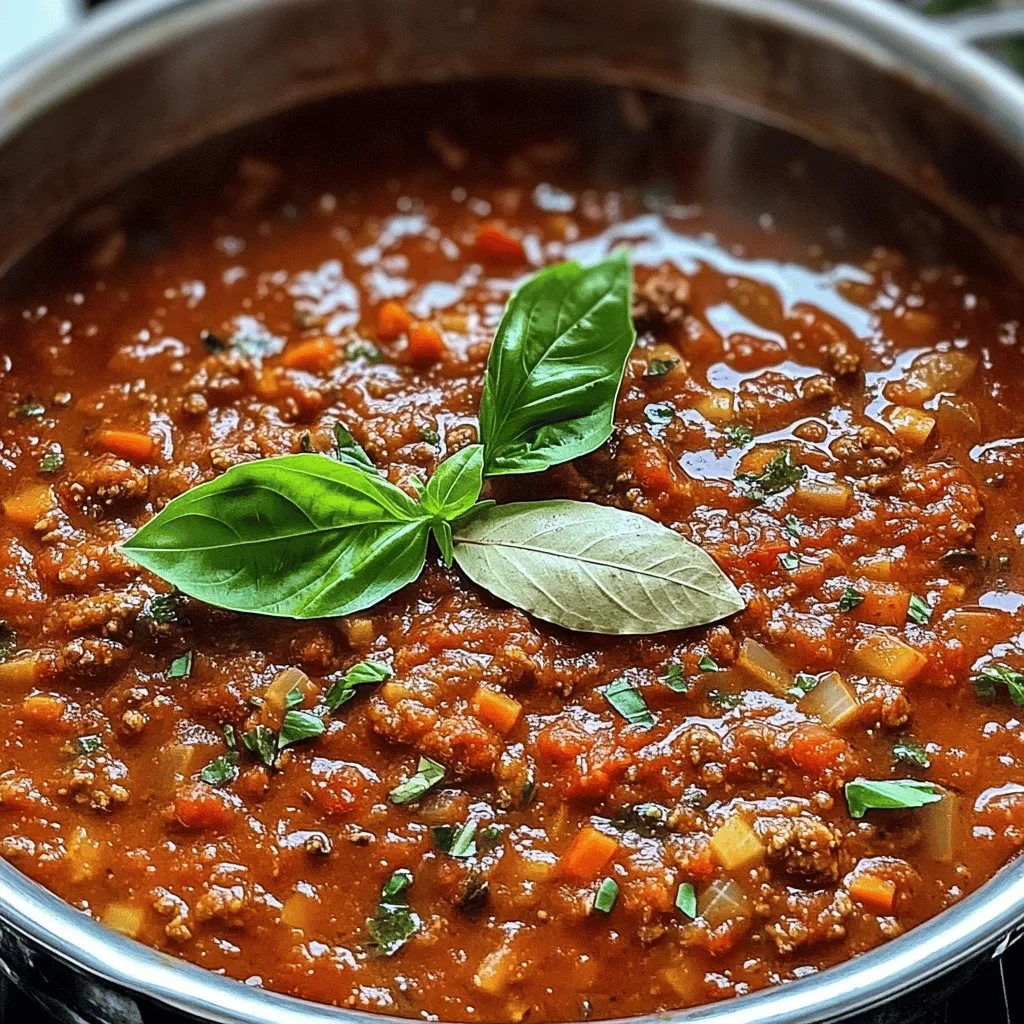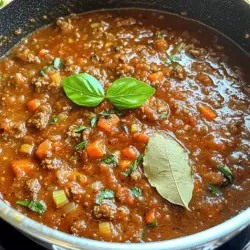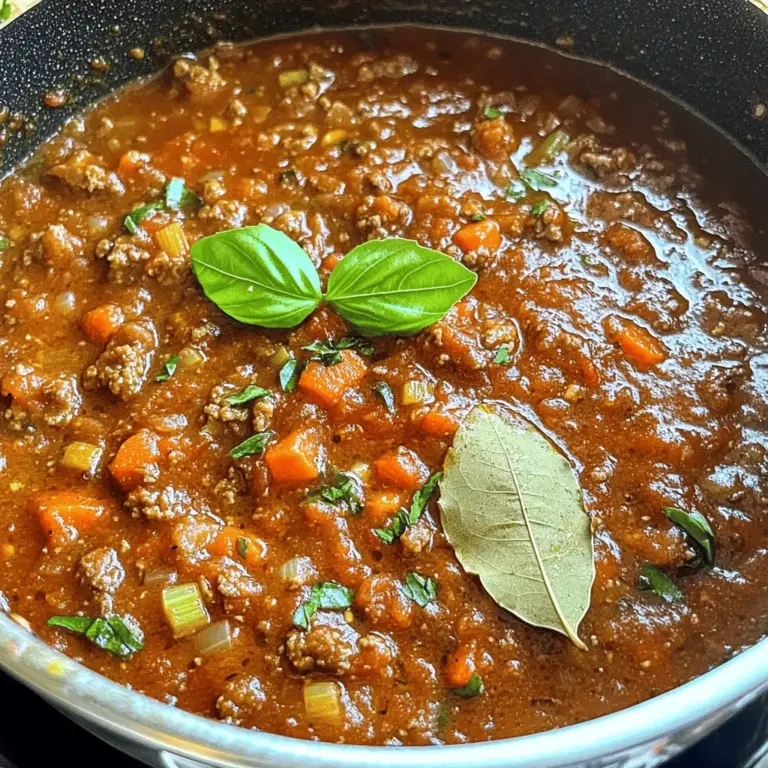Ready to elevate your pasta night? I’m here to share my simple and flavorful homemade spaghetti sauce recipe. With just a few fresh ingredients and easy steps, you can create a sauce that beats store-bought versions every time. I’ll guide you through the essentials, clever tips, and even tasty variations. Say goodbye to bland sauces and hello to a rich, savory delight. Let’s get cooking!
Ingredients
Essential Ingredients for Homemade Spaghetti Sauce
To make a great spaghetti sauce, you need a few key items. Here’s the list:
– 2 tablespoons olive oil
– 1 medium onion, finely chopped
– 3 cloves garlic, minced
– 1 carrot, grated
– 1 celery stalk, finely diced
– 2 (14-ounce) cans crushed tomatoes
– 2 tablespoons tomato paste
– 1 teaspoon dried oregano
– 1 teaspoon dried basil
– ½ teaspoon red pepper flakes (optional for heat)
– Salt and pepper to taste
– 1 bay leaf
– 1 teaspoon sugar (to balance acidity)
– Fresh basil for garnish
These ingredients create a rich and tasty sauce. The crushed tomatoes form the base, while the onion and garlic add depth. Carrot and celery provide sweetness and texture.
Common Substitutes for Key Ingredients
If you don’t have something, don’t worry! Here are some substitutes:
– Olive oil: Use canola or vegetable oil.
– Onion: Shallots or leeks work well.
– Garlic: Garlic powder can substitute, but use less.
– Crushed tomatoes: Use fresh tomatoes, just chop and cook longer.
– Bay leaf: You can skip it, but it adds flavor.
– Fresh basil: Use dried basil, but reduce the amount.
Feel free to mix and match based on what you have at home. Cooking should be fun and flexible!
Tips on Choosing Fresh Produce
When selecting fresh produce, look for vibrant colors and firm textures. For onions, choose ones that feel heavy for their size. Garlic should be firm and free from sprouts. Carrots should be crisp and smooth, while celery should snap easily.
Buy ripe tomatoes, as they add great flavor. If you can, shop at local markets for the best produce. Fresh ingredients make your sauce taste amazing!Enjoy cooking!
Step-by-Step Instructions
Detailed Instructions for Cooking
Start by heating the olive oil in a large pot over medium heat. Add the chopped onion and sauté it for about 5 minutes. The onion should turn translucent. Next, stir in the minced garlic, grated carrot, and diced celery. Cook this mixture for 3 to 4 minutes until the veggies soften.
Now, pour in the crushed tomatoes and add the tomato paste. Stir well to mix everything. Then, sprinkle in the dried oregano, dried basil, red pepper flakes (if you like heat), salt, and pepper to taste. Add the bay leaf and teaspoon of sugar. The sugar helps balance the acidity of the tomatoes.
Reduce the heat to low, cover your pot, and let the sauce simmer for about 30 minutes. Stir occasionally to help the flavors blend together. Before serving, don’t forget to remove the bay leaf. Adjust the seasoning if needed, and garnish with fresh basil.
Timing Tips to Ensure Perfect Sauce
Timing is key for a great sauce. The first 5 minutes are crucial for the onions. If they brown too much, they can taste bitter. When you add the other vegetables, keep an eye on them. You want them soft but not mushy.
The simmering time is also important. A full 30 minutes allows the flavors to meld. If you have more time, let it simmer longer on low heat. This gives the sauce a deeper flavor. Just remember to stir it every so often!
Helpful Kitchen Tools for Preparation
You don’t need fancy tools to make this sauce. Here are some must-have items:
– A large pot or saucepan
– A wooden spoon for stirring
– A sharp knife for chopping
– A cutting board for safe prep
– Measuring spoons for accuracy
These tools will help you create a delicious sauce without any fuss. Enjoy the process and the tasty results!
Tips & Tricks
How to Enhance Flavor in Spaghetti Sauce
To boost the taste of your sauce, try these tips:
– Use fresh herbs. Chopped basil and parsley add great flavor.
– Add a splash of red wine. It brings depth to the sauce.
– Include a pinch of sugar. This helps balance the acidity of the tomatoes.
– Sauté your veggies well. Carrots and onions should be soft and sweet.
– Let it simmer. Cooking longer blends the flavors nicely.
Avoiding Common Mistakes When Making Sauce
Many home cooks face issues with spaghetti sauce. Here are some common mistakes:
– Not using enough salt. Salt brings out the flavors of the sauce.
– Skipping the sauté step. Always cook your onions and garlic before adding tomatoes.
– Overcooking or undercooking. Keep an eye on the simmering time.
– Forgetting to taste. Adjust the seasoning as you go.
– Using canned tomatoes without draining. This can make the sauce too watery.
Storing Leftovers Effectively
Proper storage keeps your sauce fresh. Here are some tips:
– Cool it down. Let the sauce reach room temperature before storing.
– Use airtight containers. This prevents air from spoiling your sauce.
– Label your containers. Write the date on each one for easy tracking.
– Refrigerate for up to one week. Make sure to use it within this time.
– Freeze for longer storage. Sauce lasts up to three months in the freezer.

Variations
Different Flavor Profiles to Try
You can change the flavor of your spaghetti sauce in fun ways. Try adding red wine for depth. Just pour in a cup after cooking the onions and garlic. Let it simmer for about five minutes. You can also use different herbs, like thyme or rosemary. These can give your sauce a fresh twist. For a smoky taste, add a bit of smoked paprika.
Vegetarian and Vegan Adaptations
This sauce works great as a vegetarian dish. Simply skip any meat and add more veggies. Zucchini, bell peppers, or mushrooms can boost flavor and texture. For a vegan option, make sure your tomato paste and other ingredients are plant-based. You can even toss in some lentils for protein. They add a nice heartiness without meat.
Adding Proteins or Vegetables for a Hearty Twist
If you want a meatier sauce, ground beef or turkey works well. Brown the meat before adding the onions. This adds rich flavor. You can also use sausage for a spicy kick. If you prefer seafood, shrimp or clams can be a tasty choice. Just add them in the last few minutes of cooking. For extra veggies, try spinach or kale. Stir them in at the end to keep them vibrant and fresh.
Storage Info
Best Practices for Refrigerating Spaghetti Sauce
To keep your spaghetti sauce fresh, store it in an airtight container. Let the sauce cool down first. This helps to prevent moisture from forming inside. Place it in the fridge right after it cools. Homemade spaghetti sauce can last up to five days in the fridge. Always check for any off smells or changes in color before using it. If it looks or smells wrong, it’s best to toss it.
Freezing Instructions for Long-Term Storage
Freezing is a great way to store extra sauce. Use freezer-safe containers or zip-top bags for best results. Make sure to leave some space in the container. This allows for expansion as the sauce freezes. You can store spaghetti sauce in the freezer for up to three months. When you’re ready to use it, just thaw it overnight in the fridge.
Reheating Tips to Maintain Flavor
When reheating your sauce, do it slowly over low heat. This helps keep the flavors rich and tasty. Stir it often to avoid burning. If the sauce seems too thick, add a splash of water or broth. This will bring back the right texture. Taste it again and adjust the seasoning if needed. Enjoy your delicious homemade sauce as if it’s freshly made!
FAQs
How long can homemade spaghetti sauce last in the fridge?
Homemade spaghetti sauce can last about 5 to 7 days in the fridge. Store it in an airtight container to keep it fresh. When you want to eat it, check for any off smells or changes in color. If it looks or smells okay, it should be safe to eat.
Can I make spaghetti sauce in advance?
Yes, you can make spaghetti sauce in advance! In fact, it often tastes better the next day. Just cook the sauce and let it cool. Then, store it in the fridge or freezer. If freezing, use a container that can handle the cold well. When you are ready, just thaw and reheat it.
What are the best types of pasta to serve with homemade sauce?
Many pasta types work well with homemade sauce. Here are a few favorites:
– Spaghetti
– Penne
– Fettuccine
– Fusilli
– Rigatoni
Spaghetti is the classic choice, but any of these will absorb the sauce well. Pick your favorite or try a new one!
In this article, we explored making homemade spaghetti sauce. We covered essential ingredients and their substitutes, plus tips for choosing fresh produce. The step-by-step instructions ensure you create the perfect sauce every time. We shared ways to enhance flavor, avoid mistakes, and store leftovers. You can also try fun variations with different flavors and healthy add-ins. Remember, proper storage helps maintain freshness. Now, get cooking and enjoy your delicious, homemade spaghetti sauce!

